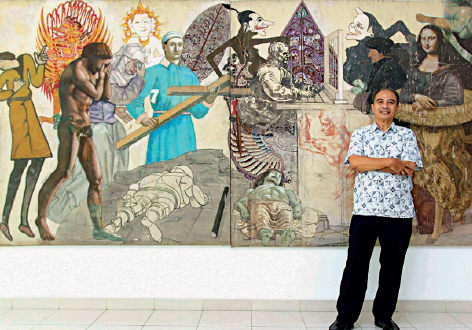“The city, parks, buildings, monuments, clothings, transportation, work equipment, furniture, and various things we use every day are always created through a process of art and design.” That’s the view of Wagiono Soenarto, who received a Fulbright scholarship to study at the Pratt Institute in New York City in the early 1980s.
At that time, he lived in a crowded district with high crime rates. There was a homicide one night, but the next day the kids were playing as if nothing had happened the night before. Wagiono watched a sanitary worker remove the bloodstains and dispose of a broken bottle in the place where children were playing cheerfully. Interestingly enough, several years later that American slum district had been restored to a healthy and scenic residential neighborhood.
That was the most valuable lesson for Wagiono, who returned to America after becoming the rector of the Jakarta Institute of Arts (IKJ) and frequently provides consultations on landscaping and museum design in several cities throughout the country.
“In addition to teaching at IKJ, in fact, until 2008, I had a studio design consultancy, ‘Vico Design,’ which conducted work in visual communication, exhibition design and museum design. Our office was involved in arranging the Indonesian Pavilions at the International Expos in Hanover, Germany; in Aichi, Japan; in Saragossa, Spain; and in Floriade, Hale Meer, in The Netherlands.” In addition, the firm worked on the Investment and Trade Fair exhibition for the government of Indonesia in a number of countries and cities around the world.
Wagiono, majoring in graphic arts, graduated from the Faculty of Fine Arts at the Bandung Institute of Technology (ITB) in 1976 and earned a master’s degree in visual communication and design from Pratt in 1983.
“While I was in the United States, I traveled a lot and camped in New York State and New Jersey. We also took a long journey by RV motorhome from Los Angeles to Yosemite, the Redwoods, Lake Tahoe, the Mojave Desert, and the Grand Canyon, to Las Vegas, San Diego, and San Francisco. For more than a month, we slept in a large caravan and parked in a wellequipped parking ground where we could take part in a variety of social and recreational activities with other campers.”
Wagiono very much enjoyed his educational and recreational experience. “The urban life and culture in New York City are also very lively. There are carnivals, Shakespeare in the Park, festivals, cinema clubs, live music and opera, Broadway and Off-Broadway, and jazz in Greenwich Village,” he said.
What is the relationship between Indonesia and the United States like? “In cultural fields, I think there is a balanced reciprocity, both in terms of programs based on cultural tradition and heritage as well as in contemporary-experimental art. Artistic exchange via academic as well as professional tracks has been running quite well,” he said.
“However, in the creative industry, we are way behind in industry infrastructure at the global level, and our national cultural-art institutions cause a lot of our creative industry artists to rise and fall even though there is competition only with the spillover from the creative industries of developed countries. The market for international creative industries in Indonesia is small and minor compared to the international market for comics, movies, software, videos, and books from overseas, which have power over our markets as spillover; we have not yet been able to compete with them at home, let alone abroad, although one or two small breakthroughs have occurred,” said Wagiono.
To enhance the cultural dialogue, Wagiono argues that we need to be aware of the “stammering in English” among Indonesian artists. “If portfolios and artistic skills took precedence over English language tests, the exchange of Indonesian artists to the United States would be more beneficial,” said the man born in Bandung in 1949, who earned his doctorate from the Faculty of Humanities at the University of Indonesia.




